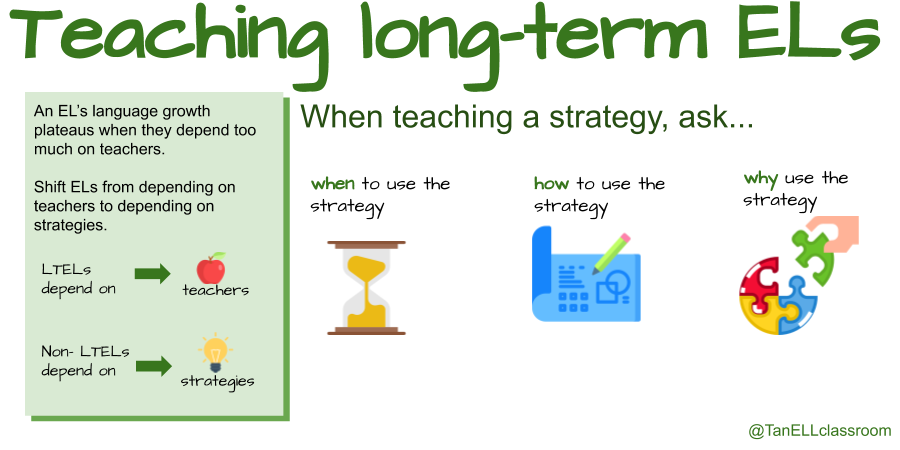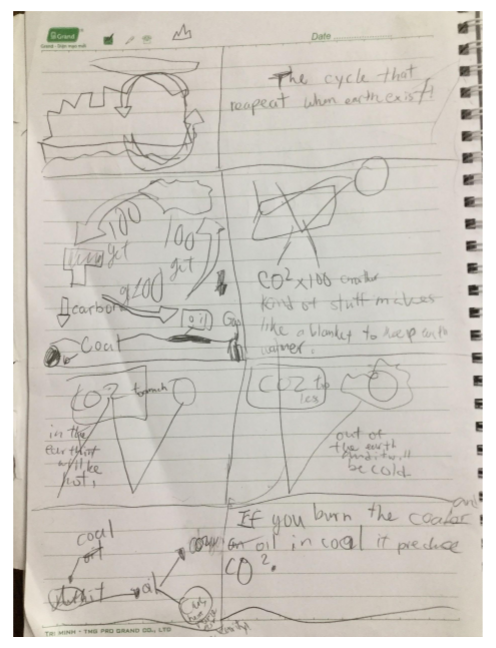Long-term ELs (LTELs) are students who struggle to exit our language services. I place LTELs into two groups. Many LTELs can navigate social interactions and follow instructions, but their grammar is mangled by missing articles, inconsistent tenses, and contorted sentence structures. For others, their spoken social language improves drastically while their written academic language remains in the informal register. Regardless of the types of LTELs you have, they remain in the program long-term because they struggle to be independent.
Let’s analyze a word. What word do you see in the word independent? Most people say that they see the word dependent. Who are LTELs usually dependent on? Teachers! We are called to this profession because we love helping and supporting ELs. In fact, Haas and Brown found that LTELs are highly susceptible to dropping out of school (2019). However, in our desire to aid them, we might be guilty of doing too much for them. Over time, they become dependent on us.
For LTELs to become more independent, they need to be dependent on strategies, not on us. They need to internalize the strategies that we use to help them comprehend content. LTELs also need to utilize the strategies we employ when writing.
In my rush to help students complete a task or to learn content, I miss the real learning opportunity: the chance to teach life strategies.
Metacognitive Students
Metacognition is the academic term for awareness or thinking about thinking (Saaris, 2017). In a school context, metacognition means students thinking about how students learn. We all have students who, after receiving instructions, raise their hands to say, “I need help” or “I don’t know what to do.” Metacognitive students ask themselves such questions as:
- What am I learning?
- What is the task?
- What are the resources?
- How can I understand the resources?
- When should I use a particular strategy?
When students ask themselves these questions, they become less dependent on us and much more dependent on the strategies that promote learning.
Likewise, metacognitive ELs think about the language they are learning and how to apply strategies to learn a language. ELs can still grow their language skills without having to be metacognitive. However, it takes them a longer time, which is why they are considered long term ELs. For LTELs, learning a language is something done to them. For the ELs that develop language more quickly, language is something that they do for themselves.
Metacognitive ELs ask such questions as:
- How is English different than my home language?
- How is English similar to home language?
- What strategies can I use to understand?
- What strategies can I use to communicate?
Hattie’s research suggests that students who think metacognitively are more likely to make a year and a half of growth for every year of instruction (2008).
Applying Hattie’s research to ELs, we can infer that LTEL students are not as adept at thinking about or reflecting on how to learn a language. They just allow learning a language to happen instead of actively employing strategies to make learning a language more effective.
Teaching metacognitive thinking
Whenever I teach, I make an effort to ask students to reflect on the effectiveness of the strategies they used to learn. This reflection is the main way that I teach metacognition. For example, I was working with a 5th grader named Long. He has plateaued in his language development because he has not yet been able to make the switch from social to academic language when talking about school content.
During one particular session, I had to pre-teach the carbon cycle to prepare him for tomorrow’s class. The teacher provided an article and video as resources. We decided to use the Youtube video first. As I worked with him, I said, “Long, because we’re watching a science video, there’s going to be lots of facts. What are some strategies we can use to help us watch a science video?”
He mentioned things such as:
- pausing the video to think about the information
- turning on the subtitles
- auto-translating the subtitles from English to Vietnamese, and
- slowing down the speed of the video.
He identified pausing the video as the strategy he wants to try. I asked him when we should use that strategy. Long answered that when there is new information or when there’s too much information to understand. I praised him for his reflection, and we started watching the video.
When he paused, I asked him what he understood. After Long explained what he had learned, I asked him what he might do to remember it. This led to a discussion about the need for taking notes. Since he is familiar with mind-mapping note taking, I suggested a box method where one side contained a place for him to draw pictures and the other side was reserved for making notes about the drawing.
We continued watching the rest of the video – periodically stopping it to allow him to process the information and transfer his understanding onto his notebook. To develop his metacognition, I had him reflect on how this box-drawing-annotating method worked for him compared to the mindmap. Long said that he preferred this method more because he could draw images and not just take written notes. The last question I asked was, “Why is it important to take notes while watching a science video?”, and he gave thoughtful, appropriate responses.
There were two layers to this lesson:
- Content: the carbon cycle.
- Process: what strategy he used to learn the content
In the video below, you will see my metacognitive reflection with Long about note-taking.
The Metacognitive Questions
I would argue that every lesson has content and opportunities to think metacognitively about learning. If we teach only content without teaching metacognitive skills, then we’ve only taught half the lesson. Teaching content without teaching metacognitive thinking ensures that students become dependent on us because they do not have strategy awareness.
Echevarria, Vogt, and Short (2017) suggest in Making Content Comprehensible for English Learners (5th edition) that there are three things we have to teach when teaching a strategy:
- When to use the strategy
- How to use the strategy
- Why use the strategy
In the lesson with Long, I go through each of these phases with him.
- When to use the strategy: When watching a science video, we need to use strategies to understand the content.
- How to use the strategy: Create two columns, one for images and one for writing.
- Why use the strategy: Science content builds on each other, so understanding each part of a process is important to fully understand the whole.
Takeaway
In the future, I will teach Long to ask these questions to himself when he learns new content. However, the first step is to just have him stop and realize that there are strategies we can use to make learning easier. This leads to greater independence and confidence. Strategies empower students and make them feel that they are capable, competent, and intelligent. They start to develop a sense of agency and comfort about school rather than feeling marginalized and struggling.
As he becomes more metacognitive, I can shift his awareness to other strategies that he can use to help him learn a language, to switch from a social to an academic register, and to examine similarities between Vietnamese and English.
Students do not become Long-Term English learners by choice. They are just not aware that there are strategies to choose from to improve their learning experiences. When they develop this awareness, their language won’t plateau but will grow towards the sky and beyond.
Echevarria, J., Vogt, M., & Short, D. J. (2017). Making content comprehensible for English learners: The SIOP model. Boston: Pearson.
Haas, E., & Brown, J. E. (2019). Supporting English learners in the classroom: Best practices for distinguishing language acquisition from learning disabilities. New York: Teachers College Press.
Hattie, J. (2008). Visible learning: A synthesis of over 800 meta-analyses relating to achievement. Abingdon: Routledge.
Saaris, N. (2017, February 23). Mastering Metacognition: The What, Why, and How. Retrieved from https://www.activelylearn.com/post/metacognition



